H.G.Co. Petticoat Beehives
by H.G. "Bea" Hyve
Reprinted from "Crown Jewels of the Wire", January 1996, page 21
A Closer Look - Part 2
The nickname "beehive" was never used by Samuel Oakman in his
patent spec. John C. Tibbitts introduced the designation in 1967. Oakman
referred to this shape as a "paraboloid traversed by an equatorial groove
", which is our beehive of today.*
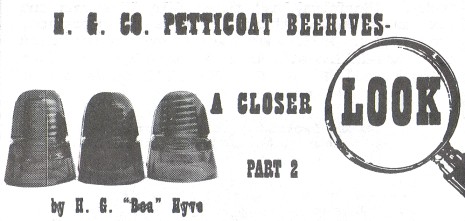
"H. G. CO."
The "H. G. CO." embossing on the front of "our" beehives
(those being discussed in this article) stands for "HEMINGRAY GLASS COMPANY"
. ( See Figure 13 ) This Western Union-style double petticoat beehive (CD 145)
was apparently the first insulator made by Hemingray to be marked "H. G. CO.", and was the first insulator made by them that involved someone else's
patent indirectly. It was almost certainly a product of the company's plant at
Covington, Kentucky. (Hemingray had three main locations and six names during their 85
years of operation, from 1848 to 1933, when the company was purchased by Owens-Illinois.
This information is given below.)
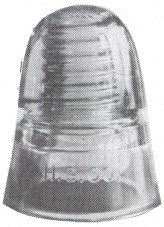
Figure 13
Front ''H. G. CO." embossing
(Courtesy of Chris Hedges)
- - - - - - - - - - - -
* In a 1904 letters patent (No. 778,005) by Charles Booker (a distant
relative of mine, I believe), he used the beehive design to illustrate his idea
for a pin. But he called it "the usual hood-shape form".
All H. G. CO. PETTICOAT molds
having freehand engraving are Covington molds, and were not used at Muncie.
Hemingray had sold large numbers of other insulators to Western Union prior to
this, but they had all been, up to this time, a uniquely Hemingray design. This
beehive wasn't, which may have been one reason for the H. G. CO. embossing. (Almost
certainly Hemingray would have felt obligated to include Oakman's patent if
he had marked them with the "1871" embossing. So the logical choice
was the H. G. CO. mark.)
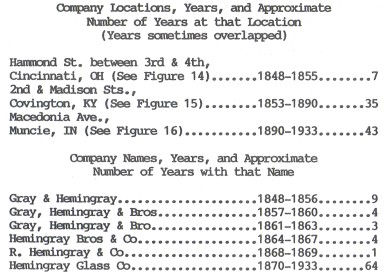
An important point to note is that all insulators
marked with "H. G. CO." are Western Union or some standard design also
manufactured by many other glassworks'. (Unfortunately, Hemingray did not
bother to register this mark with the Patent Office, so finding the year it was
first used is difficult. The earliest use is probably found on the base of beer
and soda bottles made sometime in the 1870s.)
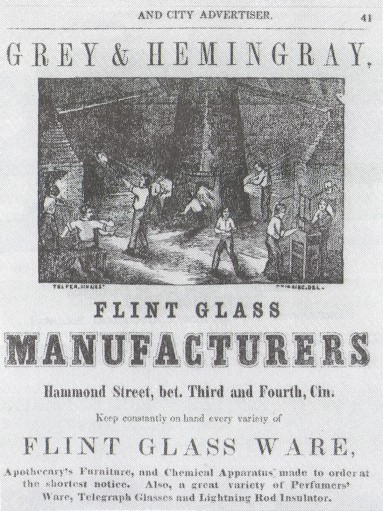
Figure 14
Company ad in Gray's Cincinnati Business Mirror & City Advertiser
1851-1852
Showing the interior and furnace at Hammond St.
(Photo B-95-206 Courtesy of The
Cincinnati Historical Society)
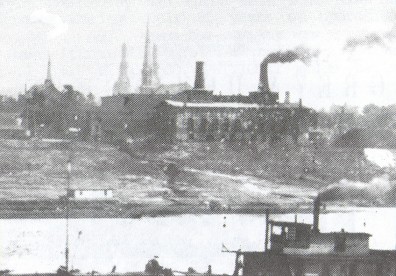
Figure 15
The Hemingray Glass Co. at Covington
c. 1870s
(Courtesy of the Cincinnati
Historical Society)
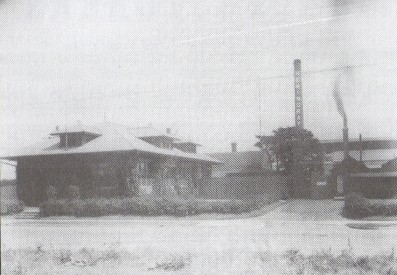
Figure 16
Muncie plant and offices at left
c. early 1920s
(Courtesy of Jim Sanders)
AGE AND YEARS IN PRODUCTION
How long were the H. G. CO. PETTICOAT beehives in production? It was
probably very soon after the design patent was granted to Oakman (early 1884)
that Hemingray began producing them. They were probably made as different as
possible from the exact shape and description of the Oakman patent, and yet near
enough in style so that the purchasers would be willing to use them along with
the Brookfields that were made under the Oakman design patent. But when did they
go out of production? Probably around 1895. But let's delve into some Hemingray
Glass Company history along with some embossing data in order to see how
we arrive at this latter date.
COMPANY HISTORY
Robert Hemingray, the company's founder, died in December 1898. Ralph, the
oldest son, who had been living in Muncie since 1890, became president. Ralph
and his brothers may have had a different attitude toward their father's
probable reluctance to put their name all over their insulators. In addition,
they were no doubt influenced by the other glassmakers surrounding them in
Muncie, and wanted to have a more clearly identifiable company mark. In any
event, most new insulators brought into production after 1900 were marked
"HEMINGRAY". (Exceptions were the No.4, 8, 9, and 11, which were so
marked before 1900.) There was only minimal reworking of molds, considering
the number of new designs, especially for power, being tested and produced at
that time. Also, when the word "HEMINGRAY" was registered as a
trademark on March 29, 1910, it was indicated that it had been in use for ten
years. So company history bears testimony to the fact that the "H. G. CO."
mark was phased out sometime after 1900, but was probably not done away with completely for a few more years, at least with the H. G.
CO. PETTICOAT beehives.
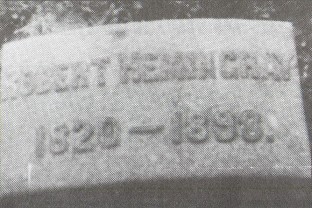
Figure 17
Grave of Robert Hemingray
1820-1898
Highland Cemetery, Covington, KY
(Courtesy
of Franklin Jaquish)
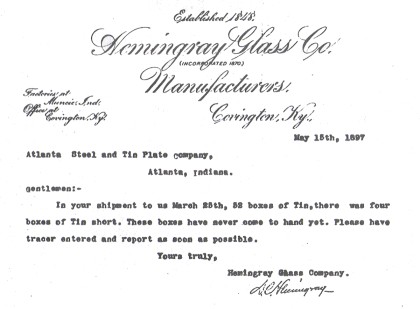
Figure 18
Hemingray Glass Co. letter
May 15, 1897
(Courtesy of James Doty)
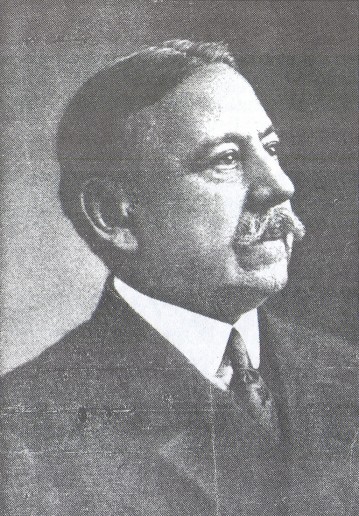
Figure 19
Ralph Gray Hemingray
1852-1920
Oldest son of Robert Hemingray
c. age 48
c.
1900
From History of Delaware County, Indiana, Vol. II, 1924
(Courtesy of Ruth
Crawford and the Muncie Public Library)
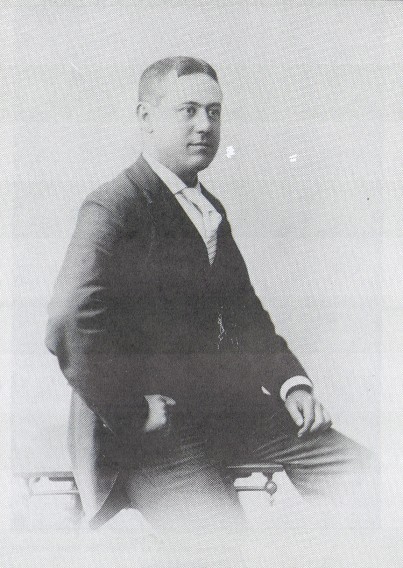
Figure 20
Daniel Carroll Hemingray
1857-1911
Youngest son of Robert Hemingray
Age 36
July 1893
(Courtesy of the Cincinnati Historical Society)
EMBOSSING DATA AS RELATED TO AGE
The Hemingray insulators of the period of which we are speaking can be dated
by two means; the type of embossing, and the type of glass. There was a type of
embossing used during approximately the period from 1910 to 1918 (but
possibly several years earlier) which was formed with a set of premanufactured
characters that were in some way stamped into the molds. Al though the method in
which this was done is not known, the differentiation is so clear that it does
make a rather good tool in research. With a few exceptions to the rule, it is
probably safe to say that the hand-engraved letters that appear on most H. G.
CO. PETTICOAT beehives (see Figure 21) would place them as being manufactured
no later than about 1910. (More on this later on under "EMBOSSING DETAILS".)
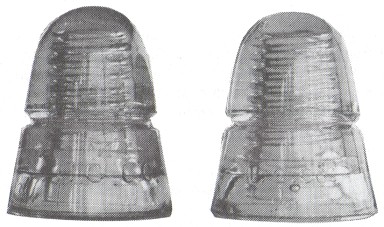
Figure 21
Hand-engraved letters on left, machined letters on right
(Courtesy of Chris
Hedges)
More in Part 3 next month...
| 